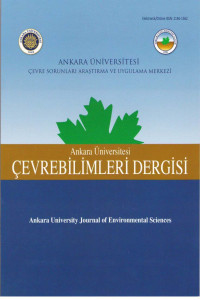Havza Bazında Peyzaj Planlaması (Rodop Dağı’nın Tipik Havzalarından Örnek Bir Çalışma)
Bu makale, Bulgaristan’nın güneyinde, Rodop Dağı’nın batısındaki Arda nehrinin yukarı havzasında yapılan peyzaj planlamasının ilk evresine ait sonuçları ortaya koymaktır. Çalışma, doğal havza sınırlarını kullanarak bölge planlaması ve çok fonksiyonlu peyzaj sistemleri kavramını uygulayarak kaynak geliştirmeye odaklanmıştır. Arda nehrinin yukarı çığırı, yenilenebilir enerji potansiyelini de içeren, ülkedeki başlıca su ve orman kaynaklarına sahiptir. Aynı zamanda Arda havzası küresel iklim değişikliğinin etkilediği yüksek ekolojik risk (başlıcaları taşkın ve heyelanlar) altındadır. Bu çalışmada peyzaj haritaları ve ekosistem hizmetlerinin temel verilerinin yorumlanması ve analizinde havza modelleri kullanılmıştır. Aynı zamanda burada yaşayan yerel halkın doğal sermayeyi kullanım davranışları da analiz edilmiştir çünkü alanın etrafındaki yakın çevrenin etkisiyle yerel halkın doğal kaynaklara bağımlılığı büyüktür. Araştırma başlıca peyzaj göstergelerini ortaya çıkararak alanın fonksiyonel kuşaklara ayrılmasını önermektedir, bu durum yerel eşitliği ve sürdürülebilir bölgesel yönetimi sağlayacaktır
Anahtar Kelimeler:
arazi planlaması, çok fonksiyonluluk, havzalar, ekosistem/peyzaj hizmetleri, fonksiyonel bölgeleme, peyzaj stabilizasyonu
Landscape Planning at the Catchment Scale (The Case Study of Rhodope Mountain Representative Catchments)
This article portrays the results form the first stage of an attempt at landscape planning in the upper watershed of the Arda River in the Western Rhodope Mountain, South Bulgaria. The study applies the concept of multifunctionality of landscape systems focusing on resource evaluation and territorial planning using the natural watershed boundaries. The upper valley of the Arda River is a major national-level resource regarding water and forest resources, including their renewable energy potential. At the same time, high ecological risk (primarily floods and landslides), enhanced by the global climate change, characterizes the Arda watershed. This study uses watershed models to interpret and analyze landscape maps and primary data on ecosystem services. It also analyzes public attitudes regarding the utilization of local natural capital, which are determined by the peripheral situation of the area and the high dependency of the locals on the landscape resources. The investigation proposes lead landscape indicators and functional zoning of the area, which allow for locally adequate and sustainable territorial management
Keywords:
landscape planning, multifunctionality, catchments, ecosystem/landscape services, functional zoning, landscape stabilization,
___
- Ahern, J. 1999. Spatial concepts, planning strategies, and future scenarios: a framework method for integrating landscape ecology and landscape planning. Editors: Klopatek J., Gardner R., Landscape Ecological Analysis. Issues and applications, Springer, New York, 175–201.
- Blaschke, T. 2006. The role of the spatial dimension within the framework of sustainable landscapes and natural capital, Landscape and Urban Planning, 75, 198-226.
- Blaschke, T., J. Petch. 1999. Landscape structure and scale: comparative studies on some landscape indices in Germany and the UK. Editors: Maudsley M., Marshall J., Heterogeneity in Landscape Ecology: Pattern and Scale, International Association of Landscape Ecology UK, Bristol, 75–84.
- Borissova, B. Sub-Mediterranean Forest Landscapes of The Eastern RhodopesRhodope and Pontic Landscapes of Strandzha, Editors: Wrbka T., Zmelik K., Grunweis F.M. “The European Green Belt: Borders.Wilderness.Future”; The European Nature Conservation Project “European Green Belt”, coordinated by IUCN, Verlag Bibliothek der Provinz, Linz, 214-217.
- Botequilha Leitão, A., Ahern, J., 2002. Applying landscape ecological concepts and metrics in sustainable landscape planning, Landscape and Urban Planning, 59, 65-93.
- Brunckhorst D., Coop Ph., Reeve I. 2006. ‘Eco-civic’ optimisation: A nested framework for planning and managing landscapes, Landscape and Urban Planning, 75, 265–281.
- Buček, A., Lacina, J. and Löw, J. 1986. Územní systémy ekologické stability krajiny. Životné prostredie, 20, 82–86.
- Forman, R. T. T. 1995. Land Mosaics: The Ecology of Landscapes and Regions, Cambridge Univ. Press, Cambridge.
- Fry, G. 2001. Multifunctional landscapes – towards transdisciplinary research. Landscape and Urban Planning, 57, 159–168.
- Gikov, A., Nedkov St. 2009. Landscape Atlas of the RhodopesRhodope. Rhodope Project (UNDP).
- Gustafson, E. J. 1998. Quantifying landscape spatial pattern: what is the state of the art. Ecosystems, 1, 143–156.
- Haase, G. 1989. Medium scale landscape classification in the German Democratic Republic, Landscape Ecology, 3, 29–41.
- Hawkins, V., P. Selman. 2002. Landscape scale planning: exploring alternative land use scenarios. Landscape and Urban Planning, 60, 211-224.
- Hornung, M., Reynolds B. 1995. The effect of natural and anthropogenic environmental changes on ecosystem processes at the catchments scale, Trends in Ecology & Evolution, 10, 443-449.
- Lavers, C., R. Haines-Young. 1993. Equilibrium landscapes and their aftermath: spatial heterogeneity and the role of new technology. Editors: Haines-Young R., Green D., Cousins S., Landscape Ecology and GIS, Taylor and Francis, London. 57–74.
- Miklós, L., 2010. The most successful landscape ecological concepts in the practice. The Problems of Landscape Ecology, 28. 15–22.
- Mücher C.A., Klijn J.A., Wascher D.M., Schaminee J.H.J., 2010, A new European Landscape Classification (LANMAP): A transparent, flexible and user-oriented methodology to distinguish landscapes, Ecological Indicators, 10, 87-103.
- Nedkov. St. 2009. Analyzing spatial dimensions of ecosystem services and their valuation using GIS: A case study in Smolyan municipality. Problems of geography, 4.
- O’Neill, R., Johnson A., King A.. 1989. A hierarchical framework for the analysis of scale. Landscape Ecology, 3, 193-205.
- Potschin, M.B., Haines-Young R.H., 2006. “Rio+10”, sustainability science and Landscape Ecology, Landscape and Urban Planning, 75, 162-174.
- Von Haaren, Chr., Galler C., Ott St.. 2008. Landscape Planning. The basis of sustainable landscape development. Federal Agency for Nature Conservation, Leipzig. 52.
- Zonneveld, I. 1989. The land unit – A fundamental concept in landscape ecology, and its applications. Landscape Ecology, 3, 67-86.
- Асенов, Ас. 2006. Биогеография на България. (Assenov, A. Biogeography of Bulgaria) АН-ДИ Андриян Тасев, С., 393- 410; 464-477.
- Yayın Aralığı: Yılda 2 Sayı
- Başlangıç: 2009
- Yayıncı: Ankara Üniversitesi
Sayıdaki Diğer Makaleler
Çevre Koruma ve Siyasi Sınırlar: Rodop Dağları'nda Natura 2000
Dağ Mirasının Korunmasında Sınır Ötesi Đşbirliği - Karpat Deneyimi
Havza Bazında Peyzaj Planlaması (Rodop Dağı’nın Tipik Havzalarından Örnek Bir Çalışma)
Dağ Köylerinde Kırsal Turizm Gelişim Modelleri
Dağ Köylerinde Turizmde Arz ve Talep Alan Araştırması: Batı Rodoplar Mimari Rezervleri Örneğ
Ashfaq Ahmad KHAN, Mehmet SOMUNCU
Sürdürülebilirlik ve Kalkınma Arasındaki Dağlar: Dağlık Alanlarda Sürdürülebilir Kalkınma Yönetimi
Güneydoğu Avrupa Dağlarında Bölgesel Bilimsel Ağlar: Bir Sosyal Ağ Analizi Yaklaşımı
